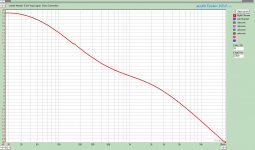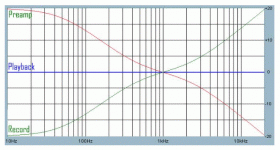Amphom 0.1uF 630VDC for interstage arrived today, size is the same that russian FT-3 teflon, photo:
An externally hosted image should be here but it was not working when we last tested it.
Last edited:
The issue I am having, and have had even before v1.2 was that the bass is not a strong as I would like. Given response of riaa I will look towards TT as culprit. I even pulle he TT stand out and away from speaker thinking it was being effected but no diff.
If you can afford 35$00 USD for RIAA mid-bass try metallized teflon film SCR Solen 0.047uF 1000VDC are 5%, I bought matched pairs here:
Teflon Tin Foil 0.047uF 1000V | Diy HiFi Supply
Photo:
An externally hosted image should be here but it was not working when we last tested it.
Had a little time to play. Started off the evening listening to it as I had left it last night. My opinion was still the same so I deceided to add the 250pF cap accross C3. The first measurement shows represents what the impact was. I could not really see a change, but I listened to it. I noted a small reduction in the extreme high end, it was a little better. I gave it a couple of sides of albums and decided to kick it up another notch. THis time I replaced the 15nF polystyrene cap with a 15.1nF poystyrene cap. so basically in total I have added 350pF or so to C3. The measurment is the second plot. Again not a huge change in the measurement. I have been listening to it ever since. At this point I don't want to change it again for another couple of days as the cap breaks in. Went back over some of the same albums and my initial perception is that the mids are more pronounced. Still great detail and stage.
In a nutshell, I can't measure the change, but it has changed perceptively. It will be interesting to see if my impression stays the same tomorrow. I wonder how much is me wanting a change.
For somereason I can't upload the graphs right now. will try later.
I saved them ib bmp format. Here is the last in jpg format.
In a nutshell, I can't measure the change, but it has changed perceptively. It will be interesting to see if my impression stays the same tomorrow. I wonder how much is me wanting a change.
For somereason I can't upload the graphs right now. will try later.
I saved them ib bmp format. Here is the last in jpg format.
Attachments
Last edited:
In simulation it would give a 0.1-0.2dB overall trend above 1kHz. There it shows. With pink noise and cards its difficult. I see easier such differences if I watch with 1/96 oct. but there will be no lows to see, they shrink bandwidth with such an octave resolution. Now its subjectively tamer maybe you can feel the lower notes progressing better.
P.S. Textbook Riaa at 50Hz=16.95dB, 40Hz=17.79dB, 30Hz=18.59dB, 20Hz=-19.27dB, 5kHz=-8.21dB, 10kHz=-13.73dB, 20kHz=-19.63dB. I.e. your graph looks good I think.
P.S. Textbook Riaa at 50Hz=16.95dB, 40Hz=17.79dB, 30Hz=18.59dB, 20Hz=-19.27dB, 5kHz=-8.21dB, 10kHz=-13.73dB, 20kHz=-19.63dB. I.e. your graph looks good I think.
Attachments
Keep On Truckin
Hello Salas,
Don’t stop truckin now. There are still more JFET filter circuits to explore. How about an active line level crossover, Salen -Key, Linkwitz- Riley style?
I have purchased too many JFETS.
DT
All just for fun!
Enjoy then. No worries. Hope to see its final construction with the R-Cores at a point. It was a nice journey IMHO.
Hello Salas,
Don’t stop truckin now. There are still more JFET filter circuits to explore. How about an active line level crossover, Salen -Key, Linkwitz- Riley style?
I have purchased too many JFETS.
DT
All just for fun!
I have passive crossed speakers, so no need. I just design things given a need and a test application. Plus I avoid more electronics in the active chain given there is a way around it. If playing with active multiway, the shaping and crossing needs and ideas will be so many that I would surely prefer a DSP processor. There are better grade ones in second hand pro. I have used many in pro sound reinforcement. Analogue filters have a limited set of options. Maybe good if combined with passive traps and zobels in a given mature speaker system.

Merlin, I may look into those at some point. How close to the stated value were they when you recieved them?
SGregory, are +-5% I asked matched pair but I received one 45.4nF & the other 46.00nF
For small values teflon film & aluminium foil (15$00 each + 1$00 each matched + shipping) also have 15nF & 1nF for RIAA, you can order to Mark here:
Surplus USA Film Capacitors Teflon Polycarbonate Polyester Polypropylene
E-mail: marko@33audio.com
Cheers
Felipe
Using your comment above, and measureing on the plot on the pc using the cursor bar, this thing is spot on to the RIAA standard now. At least within +/- 0.05dB as the cursor is limited to 0.1 dB.
Wow, nice work congratulations
Last edited:
Amphom 0.1uF 630VDC for interstage arrived today, size is the same that russian FT-3 teflon, photo:
An externally hosted image should be here but it was not working when we last tested it.
Are in break-in process but initially rocks better than russian FT-3, now the music have more emotion, rhythm, voices are more near reality, more focused & three-dimensional, that's the problem to have the silver/gold/oil Mundorf as output cap: you can listen very easy the differences, about compare vs russian don't make sense: 35$00 Amphom & 5$00 FT-3, I believe that FT-3 problem is that aren't tight bounded because the sound isn't focused like diffused possible due to the resonances produced supposedly due to bad bounded surely lefting excessive gaps between the aluminium foil & the teflon film because I don't find another motive for which it sounds worse than one copper foil paper in oil
Last edited:
It maybe you will prefer a mix of high quality oil caps as you got now vs Teflon in general. FT3 is very focused IMO. I have used both AmpOhm and FT-3 as you know. FT3 is more monitor, oil is more expansive in my experience. Copper foils tend to over focus around mids, especially vocals. Maybe euphonic coloration.
- Home
- Source & Line
- Analogue Source
- Simplistic NJFET RIAA

